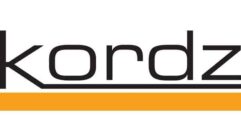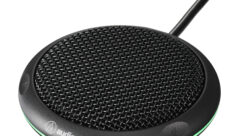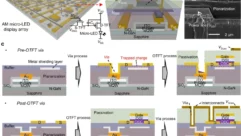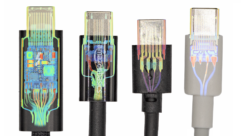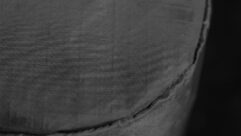Shielding is a technique used to control EMI by preventing transmission of noise signals from the source to the receiver. Shields can be located at the source, the receiver or anywhere in between. In the case of electric fields, where it is most effective, it is a function of the shield material’s thickness, conductivity and continuity.
Shielding can be applied at many points in and video systems, starting at the circuit level all the way up to the systems level, as in the case of shielded rooms. Regardless of the size of the shield, the physics of shielding remains the same.
The shield and how it works
Reflection and absorption are two principle shielding mechanisms. When an electromagnetic wave traveling through space encounters a shield, two things happen. First, much of the energy is reflected, as shown in Figure 11. Second, some of the energy not reflected is absorbed by the shield. Only the residual energy emerges from the other side of the shield. These two effects of reflection and absorption are independent, but they combine to give the overall shield effectiveness.
A third factor, called re-reflection, occurs in very thin shields. This is also shown in Figure 11. This secondary reflection occurs at the shield boundary on the far side of the shield material. This factor is fairly minor and is often ignored.
Most high-frequency shielding problems are caused by openings in the shield material, not by the material itself. Most conductive materials, such as aluminum, copper and steel, provide substantial electric shielding. For example, at frequencies from 30 MHz to 100 MHz, even aluminum foil exceeds 90 dB shielding effectiveness. Unfortunately, the same aluminum foil is extremely inadequate against low-frequency magnetic fields, where you need a thick steel or highly permeable material for adequate shielding.
Types of fields
In analyzing shielding, it is helpful to consider the three types of fields that occur. These different field types explain why the same shield can behave differently under different operating conditions.
The first type is the plane wave, which exists greater than about one-sixth of a wavelength from the source. In this condition, the ratio of the electric field to the magnetic field is a constant and equal to 377 in free space or air. The field is known as a far field or a radiation field. An example is radio waves. At 30 MHz, a wavelength is 33 feet (10m), and so any transmitter more than about 10/6 or 5.28 feet (1.6 m) away is in the far field.
The second type is the electric field. If you are less than one-sixth of a wavelength to a high-impedance source, the wave impedance is greater than 377. This is known as the near field, and capacitive energy dominates. In the near field, the losses are greater because of the higher wave impedance. This is why it is possible to do effective shielding from electric fields.
Another way of looking at this is that electric fields produce voltages in victim circuits. If you suspect that a given analog interconnect is electric field EMI, try disconnecting the wiring from the circuit driving the line and then shorting the signal pair together. Any voltage differential will be shorted out, and the input should go silent, confirming the electric field.
The third type of field is the magnetic field. If you are close to a low-impedance source (in other words, a current source), the wave impedance is less than 377. This is also the near field, but in this case, inductive energy predominates.
Reflection losses are much less because of the lower wave impedance, and this problem worsens as you drop in frequency. This is the reason that shielding is ineffective against low-frequency magnetic fields. It is also the reason balanced circuits over twisted-pair wire are important.
Another way of looking at this is that magnetic fields product current in victim circuits. If you suspect that a given analog interconnect is magnetic field EMI, try disconnecting the wiring from the circuit driving the line and leaving the signal pair open. Any current will be stopped; if the input goes silent, this will confirm magnetic field coupling.
Types of shields
Aluminum and steel are the most common shielding materials in use today. Even thin layers of these materials provide more than adequate high-frequency shielding from electric fields. Low-frequency shielding against magnetic fields must be done with steel. Aluminum is virtually transparent to low-frequency magnetic fields (those below 1 kHz).
The effectiveness of a shield can be compared to that of a bucket for water. Even a small hole in the bucket will render it useless sunder some conditions. It is very important when attempting to create shielding that the shielding surface be conductively continuous. For example, in the case of a foil shield on a cable, it is important that the way in which the aluminum Mylar shield is wrapped on the cable provides a continuous circumferential conductive bond or that there be substantial overwrap. (See Table 1.)
Table 1: Raceway shielding materials
Reprinted from ANSI/IEEE Std 518-1982, copyright by The Institute of Electrical and Electronic Engineers.
*We assume this should be No. 14.
Maintaining shield integrity
Whenever a conductive material passes through a shield (for example, when a conductor passes into a metal enclosure), the effectiveness of the shield is greatly diminished. This is because any fields impinging on the shield on one side are conducted through the shield on the conductor and reradiated on the far side of the shield. (See Figure 12.) Even the smallest opening with a conductor through it is a significant shielding problem. This explains the common use of ac line filters at the boundary of the power conductor entering electronic units. (These EMI filters are commonly terminated on an IEC-type power cord on the unit.)
Although penetration through shields can be signal or power lines, unintentional conductors can also occur, such as the control shafts on potentiometers and other switches, as shown in Figure 13.
Any opening in the shield will also diminish its effectiveness. The most interesting thing about electromagnetic leakage through slots is that the longest dimension on the opening is critical, not the total area of the opening. For example, a 10″x0.1″ (254mmx2.5mm)slot will be about 10 times more leaky than a 1″x1″ (25.4mmx25.4mm) hole, even though both have the same total area.
The general guideline is that slots should be kept shorter than one-twentieth of the wavelength of the highest frequency of concern. For example, at 100 MHz, the slot should be less than about 6 inches (152mm); at 300 MHz it should be abut 2 inches (51mm); at 1000 MHz, it should be about 0.33 inch (8mm).
These dimensions will assure at least 20 dB of attenuation at the highest frequency. For 40 dB of attenuation, the slots would have to be shorter than 1/200 of a wavelength.
The compromises resulting from openings of any sort make the idealized “barbell” approach to shielding attractive. (See Figure 14.) Coaxial connectors realize this ideal.
An actual connection to earth plays no part in EMI shielding effectiveness. The ideal EMI shield forms a continuous conductive layer around the items it protects, as shown in Figure 14. In the case of twisted, shielded-pair cable, normally terminated with an XLR, clearly an opening in the shield is at the connector. By connecting the shield to the ground of the equipment cast, the continuity of this shield is improved. It is far from perfect, because the conductors are exposed.
In the case of coaxial connectors, such as BNCs, the shield makes a circumferential connection to the cable connector, and that in turn makes a circumferential connection to the panel-mounted connector, providing 100% coverage of the inner conductor. In the case of coaxial cable, we have 100% shielding throughout the length of the interconnect (and we have a ground loop formed between the send and receive ends).
This has always been one of the difficulties of the single-ended transmission system used for video. In the case of audio equipment, the shield is never grounded at both ends to avoid this ground loop problem. At the high operating frequencies of video, maintaining the characteristic impedance of the transmission line (usually 75 ?) and high-frequency shielding are more important than maintaining the ground system integrity.
Many shields are also the equipment housing and require grounding for power safety purposes. For example, equipment racks must be grounded along with conduit and raceway, as are the chassis of most electronic equipment. In this case, the grounding is for safety purposes.


